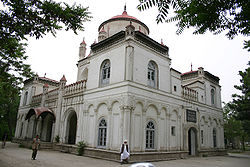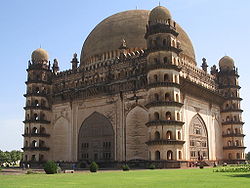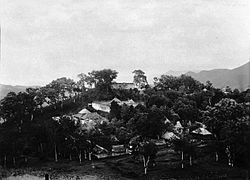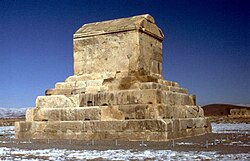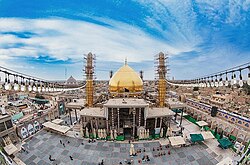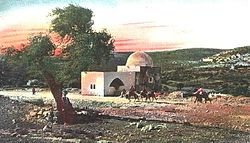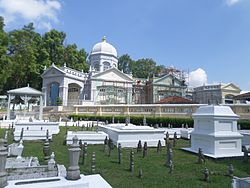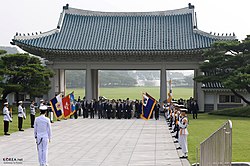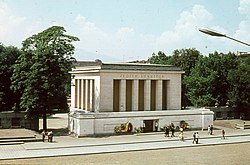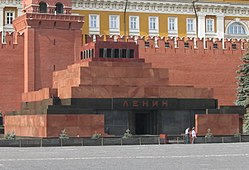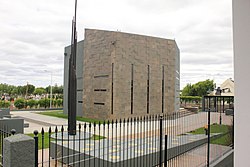Africa
Algeria
| Mausoleum | Location | Description & Image | |
|---|---|---|---|
| Royal Mausoleum of Mauretania | Tipaza Province | A monumental tomb of the Numidian Berber king Juba II and Queen Cleopatra Selene II. |  |
| Madghacen | Batna Province | A royal Numidian mausoleum dating back to the 3rd century BC. |  |
| Jedars | South of Tiaret | A series of thirteen ancient monumental Berber mausoleums. |  |
| Tomb of Masinissa | El Khroub | The tomb of Masinissa, an ancient Numidian king. |  |
| Mausoleum of Sidi Abderrahmane Et-Thaalibi | Algiers | The tomb of the patron saint of Algiers, Sidi Abderrahmane Et-Thaalibi. |  |
| El Alia Cemetery | Oued Smar | A cemetery in Algiers that contains the graves of numerous Algerian historical figures, including former presidents. |
Benin
| Mausoleum | Location | Description & Image | |
|---|---|---|---|
| Mausoleum of Hubert Maga | Parakou | The tomb of Hubert Maga, the first President of Dahomey (now Benin). | |
| Mausoleum of Mathieu Kérékou | Natitingou | The resting place of Mathieu Kérékou, who served as President of Benin from 1972 to 1991 and again from 1996 to 2006. [1] |  |
Burundi
| Mausoleum | Location | Description & Image | |
|---|---|---|---|
| Mausoleum of Pierre Nkurunziza | Gitega | The resting place of Pierre Nkurunziza, President of Burundi from 2005 to 2020. The mausoleum is officially named Mausolée du Guide Suprême du Patriotisme (Mausoleum of the Supreme Guide of Patriotism). [2] |
Comoros
| Mausoleum | Location | Description & Image | |
|---|---|---|---|
| Mausoleum of Ahmed Abdallah | Domoni | The tomb of Ahmed Abdallah, the first, third, and fifth President of the Comoros. |
Republic of the Congo
| Mausoleum | Location | Description & Image | |
|---|---|---|---|
| Mausoleum of Marien Ngouabi | Brazzaville | A memorial and tomb for Marien Ngouabi, the third President of the Republic of the Congo. | |
| Mausoleum of Pierre Savorgnan de Brazza | Brazzaville | A large memorial containing the remains of the Italo-French explorer Pierre Savorgnan de Brazza and his family. |  |
Democratic Republic of the Congo
| Mausoleum | Location | Description & Image | |
|---|---|---|---|
| Mausoleum of Laurent-Désiré Kabila | Kinshasa | The resting place of Laurent-Désiré Kabila, the third President of the Democratic Republic of the Congo, located in front of the Palais de la Nation. [3] |  |
| Mausoleum of Joseph Kasa-Vubu | Tshela | The tomb of Joseph Kasa-Vubu, the first President of the Democratic Republic of the Congo. |
Eswatini
| Mausoleum | Location | Description & Image | |
|---|---|---|---|
| King Sobhuza II Memorial Park | Lobamba | A memorial and mausoleum for King Sobhuza II, who reigned for 82 years, one of the longest verifiable reigns of any monarch in recorded history. |  |
Ethiopia
| Mausoleum | Location | Description & Image | |
|---|---|---|---|
| Grave of Meles Zenawi | Holy Trinity Cathedral, Addis Ababa | The burial site of Meles Zenawi, who served as President and later Prime Minister of Ethiopia. The cathedral is the final resting place of many notable Ethiopians, including Emperor Haile Selassie. |
Gabon
| Mausoleum | Location | Description & Image | |
|---|---|---|---|
| Mausoleum of Omar Bongo | Franceville | A large, private mausoleum for Omar Bongo, who was President of Gabon for 42 years, from 1967 until his death in 2009. [4] | |
| Mausoleum of Léon M'ba | Libreville | A memorial tomb for Léon M'ba, the first President of Gabon. |
Ghana
| Mausoleum | Location | Description & Image | |
|---|---|---|---|
| Kwame Nkrumah Mausoleum | Accra | A memorial park and mausoleum dedicated to Kwame Nkrumah, the first President of Ghana and a leading figure in the pan-African movement. |  |
| Asomdwee Park | Accra | The burial site of John Atta Mills, the third President of the Fourth Republic of Ghana. |  |
Guinea
| Mausoleum | Location | Description & Image | |
|---|---|---|---|
| Camayanne Mausoleum | Within the Grand Mosque of Conakry, Conakry | The resting place of Guinea's national heroes, including Ahmed Sékou Touré, Samori Ture, and Alfa Yaya of Labé. [5] |
Guinea-Bissau
| Mausoleum | Location | Description & Image | |
|---|---|---|---|
| Mausoleum of Amílcar Cabral | Bissau | A memorial and tomb dedicated to Amílcar Cabral, an anti-colonial leader, intellectual, and diplomat. |  |
Ivory Coast
| Mausoleum | Location | Description & Image | |
|---|---|---|---|
| Mausoleum of Félix Houphouët-Boigny | Yamoussoukro | The family tomb of Félix Houphouët-Boigny, the first President of Ivory Coast, located near the Basilica of Our Lady of Peace of Yamoussoukro. |
Kenya
| Mausoleum | Location | Description & Image | |
|---|---|---|---|
| Mausoleum of Jomo Kenyatta | Nairobi | The resting place of Jomo Kenyatta, the first President of Kenya, located on the grounds of the Parliament Buildings. Access is generally restricted. [6] |  |
| Tom Mboya Mausoleum | Rusinga Island | A mausoleum dedicated to Tom Mboya, a prominent Kenyan trade unionist and politician who was assassinated in 1969. |
Liberia
| Mausoleum | Location | Description & Image | |
|---|---|---|---|
| Centennial Pavilion | Monrovia | The final resting place of former president William Tubman. The pavilion is also used for presidential inaugurations. |
Malawi
| Mausoleum | Location | Description & Image | |
|---|---|---|---|
| Kamuzu Mausoleum | Lilongwe | A monumental marble and granite tomb dedicated to Malawi's first president, Hastings Kamuzu Banda. [7] |  |
| Bingu wa Mutharika Mausoleum | Thyolo District | A large, modern mausoleum known as "Mpumulo wa Bata" (Peaceful Rest), housing the remains of Bingu wa Mutharika, the third President of Malawi. |
Mozambique
| Mausoleum | Location | Description & Image | |
|---|---|---|---|
| Praça dos Heróis Moçambicanos (Heroes' Square) | Maputo | A national monument and public square that serves as the burial site for Mozambique's national heroes, including Samora Machel and Eduardo Mondlane. [8] |  |
Namibia
| Mausoleum | Location | Description & Image | |
|---|---|---|---|
| Heroes' Acre | Windhoek | An official war memorial of the Republic of Namibia. It includes a cemetery with the graves of national heroes and heroines, as well as an eternal flame and a large obelisk. |  |
Nigeria
| Mausoleum | Location | Description & Image | |
|---|---|---|---|
| Mausoleum of Nnamdi Azikiwe | Onitsha | A mausoleum dedicated to Nnamdi Azikiwe, the first President of Nigeria. |  |
| Tomb of Abubakar Tafawa Balewa | Bauchi | The final resting place of Sir Abubakar Tafawa Balewa, the first and only Prime Minister of independent Nigeria. |  |
| Mausoleum of Sani Abacha | Kano | The tomb of Sani Abacha, the de facto President of Nigeria from 1993 to 1998. |  |
South Sudan
| Mausoleum | Location | Description & Image | |
|---|---|---|---|
| Mausoleum of John Garang | Juba | The final resting place of Dr. John Garang de Mabior, a Sudanese politician and revolutionary leader, and the first President of Southern Sudan. [9] |  |
Sudan
| Mausoleum | Location | Description & Image | |
|---|---|---|---|
| Mausoleum of The Mahdi | Omdurman | The tomb of Muhammad Ahmad, a Sudanese religious leader of the Samaniyya order in Sudan who, on 29 June 1881, proclaimed himself the Mahdi. |  |
Tunisia
| Mausoleum | Location | Description & Image | |
|---|---|---|---|
| Bourguiba mausoleum | Monastir | A monumental grave in Monastir, Tunisia, housing the remains of the former president Habib Bourguiba, the father of Tunisian independence. |  |
Togo
| Mausoleum | Location | Description & Image | |
|---|---|---|---|
| Mausoleum of Gnassingbé Eyadéma | Pya, Kara | The family mausoleum of Gnassingbé Eyadéma, who was the President of Togo from 1967 until his death in 2005. |  |
Zambia
| Mausoleum | Location | Description & Image | |
|---|---|---|---|
| Embassy Park Presidential Burial Site | Lusaka | A national monument that serves as the burial site for the country's deceased presidents, including Levy Mwanawasa, Frederick Chiluba, and Michael Sata. [10] |  |
Zimbabwe
| Mausoleum | Location | Description & Image | |
|---|---|---|---|
| National Heroes' Acre | Harare | A national monument and burial ground administered by the National Museums and Monuments of Zimbabwe. It includes the Tomb of the Unknown Soldier. |  |



